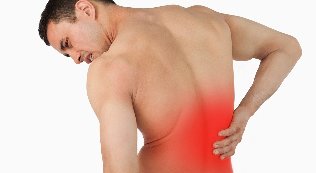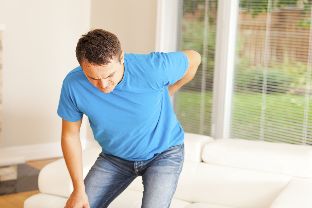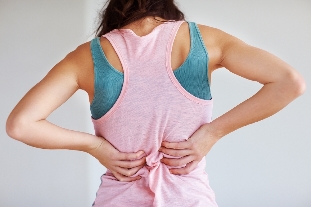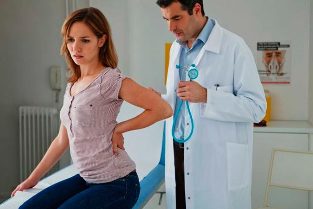The back pain is often a symptom. Most people at least once in their life in front of him. This is one of the most common reasons for visits to the doctor and the transition to work.

Key words: back pain, back pain, vertebral column
The back pain can occur at any age, but is most common between 35 and 55 years. The back pain is related to how our bones, muscles, intervertebral discs, ligaments, tendons, and nerves.
The back pain may be caused by problems with the vertebrae, discs between them, beams around the spine and discs, spinal cord and nerves, muscles of the back, the internal organs in the abdominal and pelvic areas. Also the cause of the pain in the upper back can become diseases of the aorta, cancer of the chest and inflammation of the spinal column.
The risk factors
The presence of risk factors increases the likelihood of developing or of another state. For example, obesity significantly increases the risk of diabetes of the second type.
The following factors are associated with increased risk of emergence of pain in the back:
- office work;
- the work, together with the constant stress;
- pregnancy pregnant women often suffer from pain in the spine;
- a sedentary life-style;
- age;
- depression;
- obesity/overweight;
- structure;
- heavy physical exercises;
- the heavy physical work.

Signs and symptoms of back pain
The symptom is what the patient feels, and then, as a sign, can see a doctor. For example, pain is a symptom, as the eruption of a - sign.
The main symptom for the low back pain is a pain in any part of the back. Sometimes the pain extends to the buttocks and legs or on the shoulder and hands.
You should immediately contact a doctor if the pain in the spine accompanies any of the following signs:
- weight loss;
- high temperature (fever);
- the back pain is not eased after the break;
- pain, pain that radiates to the leg;
- the pain goes below the knee;
- the presence of a fresh wound of the spinal column;
- urinary incontinence (a small portion);
- difficulty passing urine - the urine passes with difficulty;
- the fecal incontinence - loss of control on the process of defecation;
- numbness in the genital area;
- numbness in the area of the anus;
- numbness in the buttocks.
Contact for technical support, if you belong to one of these groups:
- people under the age of 22 or over the age of 55 years;
- patients who took steroids a few months;
- patients with cancer;
- the patients, once the cancer;
- patients with low immunity.
Causes of back pain
The human spine is a complex structure composed of muscles, ligaments, tendons, disks and bones. Intervertebral discs are between each pair of vertebrae and act as shock absorbers of the friction. Problems with any of these components can cause pain in the spine. In some cases, the cause of the pain cannot be established.

Traction
The most common causes of pain in the spine are:
- stretched muscles;
- strained ropes;
- lifting a heavy object in an incorrect posture;
- the climb is too heavy object;
- the result of a strong and awkward of movement;
- a muscle spasm.
Structural problems
The following structural problems can lead to the appearance of pain in the spinal column:
- protrusion of the intervertebral disc disk. Rupture of the outer shell of the disc leads to vbuhanie its internal contents to the outside. This can lead to pinching of the nerve and therefore pain;
- herniated intervertebral disc - protrusion internal the contents of the large disk;
- sciatica - acute and lancinating pain that radiates to the buttock and back area of the foot, caused a protrusion or hernia intervertebral disc, compressing the nerve;
- arthritis - patients with osteoarthritis usually have problems with the joints of the hip, lumbar spine, knees and hands. In some cases it can occur that the stenosis of the spinal canal, as well as the space around the spinal cord narrows;
- abnormal curvature of the spine - if the spine bends in an extraordinary way, a patient with an increased likelihood of suffering from spine pain. An example of the abnormal curvature is scoliosis, where the spine bends to the side;
- osteoporosis the bones, including the vertebrae become porous and brittle, which leads to an increase of their fragility.
Here are some other causes of pain in the spine:
- the syndrome of the cauda equina - horse's tail) is a bundle of nerve roots that branches off the spinal cord. People with cauda equina syndrome feel a dull pain in the lumbar spine and buttocks. It can also be loss of feeling in the buttocks, genitals, thigh. Sometimes people with cauda equina syndrome suffer from urinary incontinence and/or fecal;
- cancer of the spine - a tumor located in the spine, can compress the nerve that causes pain;
- infection of the spine - if the patient is high, the temperature of the body, but also a painful hot region on the back, then you can talk about infection of the spinal column;
- other infection - pelvic inflammation in women, as well as infections of the bladder and of the kidneys can also cause pain in the back;
- sleep disorders - people with sleep disorders, often feel pain in the spine than in the general population;
- herpes zoster is an infection that can affect the nerves;
- the wrong mattress - if the mattress does not support some parts of the body and does not provide to adjust the position of the back, there is the risk of spine pain.
Also pain at the spinal column can become some of the movements or positions of the body, as for example along the guide, cough, etc.

What to do when the back pain
If you are experiencing pain in the spine in a matter of a few days, the following tips will help you reduce your pain and discomfort and speed of recovery:
- stay active, as much as possible;
- if necessary, use pain medication otc;
- use hot and cold packs. They are inserted, and the bottle with hot water, and a package of frozen vegetables.
Despite the fact that it is difficult to remain optimistic, when you suffer from pain, try not to lose heart. This will speed up the healing process.
Times of pain in the spinal column, which are not carried out in the course of six weeks, you should consult a doctor. The doctor will be a medical history, examination and, if necessary, send you for further research. The doctor may prescribe x-rays if you suspect a problem with your system bone or osteoarthrosis, cat (computerized axial tomography) or MRI (magnetic resonance imaging) in the case of suspicion of the intervertebral hernia or any other problems associated with soft tissues or nerves. In such a situation, magnetic RESONANCE imaging is the best choice. In addition, the doctor may advise you to overcome some of the laboratory tests, or to measure the electrical activity of the nerves (EMG).
After the diagnosis, the doctor prescribes a treatment. For the most part of cases is enough a conservative treatment, which may include:
- special exercises;
- reflexology;
- traction of the spinal column;
- the massage.
In more severe cases, it can be put in discussion the problem of proceeding with the operation. The surgeon will help You choose the method, but also advice on the possible complications. After a bit of time after the surgery is recommended the passage of the preventive treatment of the spinal column. Remember that the operation on the spine quite dangerous, as well as operating area is located in close proximity to nerves.






































